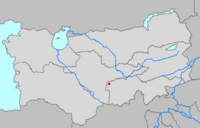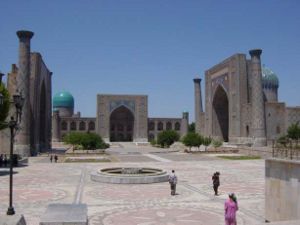Samarqand
| |||||||||
| City nickname: "NICKNAME (TURKESTANI)" ("NICKNAME (ENGLISH)") | |||||||||
 Location of Samarqand within Turkestan | |||||||||
| Province | Tajikistan | ||||||||
| Äkim | NAME OF LEADER | ||||||||
| Area | TOTAL AREA km² | ||||||||
| Population - Total (as of 2008) |
Samarqandıs 567,000 | ||||||||
| Time zone - summer (DST) |
Turkestan Time (UTC+5:00) Turkestan Summer Time (UTC+6:00) | ||||||||
Samarqand is the principal tourist destination in Turkestan and the largest city in Tajikistan. It is located very close to the border with Üzbekistan Vıloyat, and contains a large Üzbek population alongside the Tajik majority.
City Emblems
The official tamğa of Samarqand is one of the simplest and most symmetrical examples of these marks. Various explanations have been given for a symbology of the three rings; in the Snorist period, it was popularly supposed that they represented sarts, tajiks and nomads. Other commentators have seen them as representative of the three main religious groups (Islam, Assyrian Christianity and Zoroastrianism), or as being an ancient Assyrian symbolicrepresentation of the Trinity.
The city emblem of Samarqand is one of the few examples of Turkestani iconography that still depicts the Government of National Unity's eagle symbol. This is not from any particular Snorist ideology of the city administration, but more because no-one can agree what emblem to replace it with.
The city's flag is derived from the city tamğa. The red stripe is supposed to represent the blood of Samarqandı patriots shed in the various conflicts that Turkestan has been a party to.
History
Samarqand has a rich history, including being the capital city of the Empire of Timür (also known as "Tamerlane"). Timür is also buried in the city; his tomb is one of the "must-see" tourist destinations of the city, which are numerous. The conqueror of much of Persia and the Middle East spent great amounts of time beautifying and improving his capital, and the result is a visual feast of medieval Turkestani architecture. Even Jalan Quyrat-ulı had better sense than to set up any of his Vissarionovist buildings here in Samarqand.
Economy
Tourism is the main source of income for the city.
Culture
Samarqand has been home to a number of centres of learning since the time of Timür in the XIV Century, and is still home to several prestigious universities and institutes of higher learning: Avicenna University, the Samarqand Music Institute and the Assyrian seminary and university called the School of Samarqand are the three largest.
Being a university town, especially one containing two of the top five academic institutions in Turkestan, and also a major tourist destination, Samarqand is one of the most well-known cities in all of Central Asia. Both Avicenna University and the School of Samarqand are internationally recognised as two of the region's most prestigious academic institutions.
This erudite milieu has had quite an effect on a city which would otherwise probably be firmly rooted in its own past, and the city is quite cosmopolitan. It is also fairly common to hear the most arcane of subjects covered in normal conversation in the city's tea houses and qımızhanas, and lively public debates are a part of normal city business.
Another factor shaping the city's culture is the rivalry between its two biggest academic institutions: the School of Samarqand and Avicenna University. The first is Assyrian, the second, Islamic, and the sporting and academic rivalry between the two is one that spills over into the daily life of the city, with even Manesians and Zoroastrians becoming caught up in it.
Tourist Destinations
- Registan Square
- The Mausoleum of Ämir Timür
- The medieval al-Buxarı Observatory
- the Assyrian Metropolitan Cathedral of Mar Sarğıs
- Several mausoleum complexes, including the Şahı-Zındı
- The Bibi-Xanım mosque





